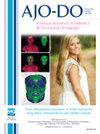Accuracy and reliability of 2 artificial intelligence platforms for cephalometric analysis compared with a semiautomatic computer program
IF 3
2区 医学
Q1 DENTISTRY, ORAL SURGERY & MEDICINE
American Journal of Orthodontics and Dentofacial Orthopedics
Pub Date : 2025-09-23
DOI:10.1016/j.ajodo.2025.04.011
引用次数: 0
Abstract
Introduction
Web-based platforms offer cephalometric tracing using artificial intelligence (AI) with varying performance levels. This study assessed the accuracy, reliability, and time efficiency of cephalometric tracings performed with the AI Web-based platforms WebCeph (Assemble Circle, Seoul, South Korea) and CephX (ORCA Dental AI, Las Vegas, Nev) in both their automated and corrected forms.
Methods
Fifty pretreatment lateral cephalograms of patients were randomly selected and traced using AI platforms WebCeph and CephX in both their automated and landmark-corrected forms, along with the Dolphin Imaging software (version 13.01; Dolphin Imaging and Management Solutions, Chatsworth, Calif) as the “gold standard.” Twelve parameters involving sagittal, vertical, dental, and soft-tissue dimensions were selected. The time required for each analysis was measured using a stopwatch. Intersystem comparisons were performed using ordinary least squares linear regression models, with Dolphin Imaging software as the reference. The intraclass correlation coefficient was used to determine the agreement among systems. A significance level of P <0.05 was applied, and 95% confidence intervals were calculated for all outcomes. Clinically relevant differences were defined as angular discrepancies greater than 2° or linear discrepancies exceeding 2 mm.
Results
The AI systems in their corrected form showed similar results to those of Dolphin Imaging software. If a 14% error is accepted, they were accurate and reliable in 11 of 12 parameters. Moreover, it was possible to reduce the tracing time by 46% compared with Dolphin Imaging software. The automated systems demonstrated low reliability and accuracy for cephalometric analysis. CephX and WebCeph are still not suitable for assessing soft-tissue parameters.
Conclusions
CephX and WebCeph platforms for cephalometric tracing are valuable diagnosis tools only when landmark correction is applied.
2种人工智能平台与半自动计算机程序头颅测量分析的准确性和可靠性比较
基于web的平台使用具有不同性能水平的人工智能(AI)提供头部测量追踪。本研究评估了人工智能基于web的平台WebCeph (Assemble Circle,韩国首尔)和CephX (ORCA Dental AI,拉斯维加斯,内华达州)在自动和校正形式下进行的头颅测量追踪的准确性、可靠性和时间效率。方法随机选择50例患者的预处理侧位脑电图,并使用人工智能平台WebCeph和CephX以自动和地标校正的形式进行跟踪,同时使用Dolphin Imaging软件(版本13.01;Dolphin Imaging and Management Solutions, Chatsworth, california)作为“金标准”。选取了矢状面、垂直面、牙面和软组织等12个参数。每次分析所需的时间都是用秒表测量的。系统间比较采用普通最小二乘线性回归模型,以Dolphin Imaging软件为参考。用类内相关系数来确定系统间的一致性。采用P <;0.05的显著性水平,所有结果均计算95%置信区间。临床上相关的差异被定义为大于2°的角度差异或超过2 mm的线性差异。结果人工智能系统在其校正形式下显示的结果与Dolphin Imaging软件相似。如果接受14%的误差,他们在12个参数中的11个是准确可靠的。此外,与Dolphin Imaging软件相比,可以减少46%的跟踪时间。自动化系统显示低可靠性和准确性的头测量分析。CephX和WebCeph仍然不适合评估软组织参数。结论scephx和WebCeph平台仅在应用地标性矫正时才具有诊断价值。
本文章由计算机程序翻译,如有差异,请以英文原文为准。
求助全文
约1分钟内获得全文
求助全文
来源期刊
CiteScore
4.80
自引率
13.30%
发文量
432
审稿时长
66 days
期刊介绍:
Published for more than 100 years, the American Journal of Orthodontics and Dentofacial Orthopedics remains the leading orthodontic resource. It is the official publication of the American Association of Orthodontists, its constituent societies, the American Board of Orthodontics, and the College of Diplomates of the American Board of Orthodontics. Each month its readers have access to original peer-reviewed articles that examine all phases of orthodontic treatment. Illustrated throughout, the publication includes tables, color photographs, and statistical data. Coverage includes successful diagnostic procedures, imaging techniques, bracket and archwire materials, extraction and impaction concerns, orthognathic surgery, TMJ disorders, removable appliances, and adult therapy.

 求助内容:
求助内容: 应助结果提醒方式:
应助结果提醒方式:


